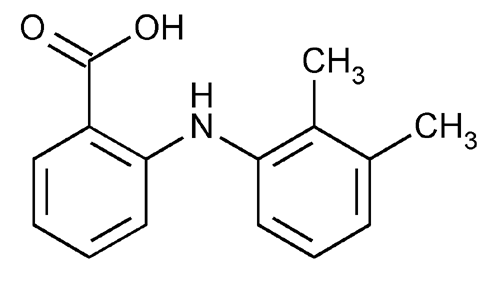Mefenamic Acid
» Mefenamic Acid contains not less than 98.0 percent and not more than 102.0 percent of C15H15NO2, calculated on the dried basis.
Packaging and storage—
Preserve in tight, light-resistant containers.
Identification—
B:
The retention time of the major peak in the chromatogram of the Assay preparation corresponds to that in the chromatogram of the Standard preparation, as obtained in the Assay.
Loss on drying  731
731 —
Dry it at 105
—
Dry it at 105 for 4 hours: it loses not more than 1.0% of its weight.
for 4 hours: it loses not more than 1.0% of its weight.
Residue on ignition  281
281 :
not more than 0.1%.
:
not more than 0.1%.
Heavy metals  231
231 :
0.002%.
:
0.002%.
Chromatographic purity—
Standard solution—
Dissolve an accurately weighed quantity of USP Mefenamic Acid RS in Mobile phase to obtain a solution having a known concentration of about 10 µg per mL.
Test solution—
Transfer about 100 mg of Mefenamic Acid, accurately weighed, to a 100-mL volumetric flask, dissolve in and dilute with Mobile phase to volume, and mix.
Procedure—
Separately inject equal volumes (about 10 µL) of the Standard solution and the Test solution into the chromatograph, record the chromatograms, and measure the responses for the major peaks. Calculate the percentage of each impurity in the portion of Mefenamic Acid taken by the formula:
100(CS / CU)(ri / rS)
in which CS is the concentration, in µg per mL, of USP Mefenamic Acid RS in the Standard solution; CU is the concentration, in µg per mL, of Mefenamic Acid in the Test solution; ri is the peak response for each impurity obtained from the Test solution; and rS is the peak response for mefenamic acid obtained from the Standard solution: not more than 0.1% of any individual impurity is found; and not more than 0.5% of total impurities is found.
Assay—
Buffer solution—
Prepare a 50 mM solution of monobasic ammonium phosphate, and adjust with 3 M ammonium hydroxide to a pH of 5.0.
Mobile phase—
Prepare a filtered and degassed mixture of acetonitrile, Buffer solution, and tetrahydrofuran (23:20:7). Make adjustments if necessary (see System Suitability under Chromatography  621
621 ).
).
Standard preparation—
Dissolve an accurately weighed quantity of USP Mefenamic Acid RS in Mobile phase, and dilute quantitatively, and stepwise if necessary, with Mobile phase to obtain a solution having a known concentration of about 0.2 mg per mL.
Assay preparation—
Transfer about 100 mg of Mefenamic Acid, accurately weighed, to a 500-mL volumetric flask, dissolve in and dilute with Mobile phase to volume, and mix.
Chromatographic system
(see Chromatography  621
621 )—The liquid chromatograph is equipped with a 254-nm detector and a 4.6-mm × 25-cm column that contains packing L1. The flow rate is about 1 mL per minute. Chromatograph the Standard preparation, and record the peak responses as directed for Procedure: the column efficiency is not less than 8200 theoretical plates; the tailing factor for the analyte peak is not more than 1.6; and the relative standard deviation for replicate injections is not more than 1.0%.
)—The liquid chromatograph is equipped with a 254-nm detector and a 4.6-mm × 25-cm column that contains packing L1. The flow rate is about 1 mL per minute. Chromatograph the Standard preparation, and record the peak responses as directed for Procedure: the column efficiency is not less than 8200 theoretical plates; the tailing factor for the analyte peak is not more than 1.6; and the relative standard deviation for replicate injections is not more than 1.0%.
Procedure—
Separately inject equal volumes (about 10 µL) of the Standard preparation and the Assay preparation into the chromatograph, record the chromatograms, and measure the responses for the major peaks. Calculate the quantity, in mg, of C15H15NO2 in the portion of Mefenamic Acid taken by the formula:
500C(rU / rS)
in which C is the concentration, in mg per mL, of USP Mefenamic Acid RS in the Standard preparation; and rU and rS are the mefenamic acid peak responses obtained from the Assay preparation and the Standard preparation, respectively.
Auxiliary Information—
Please check for your question in the FAQs before contacting USP.
Chromatographic Column—
| Topic/Question | Contact | Expert Committee |
| Monograph | Clydewyn M. Anthony, Ph.D.
Scientist 1-301-816-8139 |
(MDCCA05) Monograph Development-Cough Cold and Analgesics |
| Reference Standards | Lili Wang, Technical Services Scientist 1-301-816-8129 RSTech@usp.org |
USP32–NF27 Page 2864
Pharmacopeial Forum: Volume No. 34(2) Page 281
Chromatographic columns text is not derived from, and not part of, USP 32 or NF 27.
